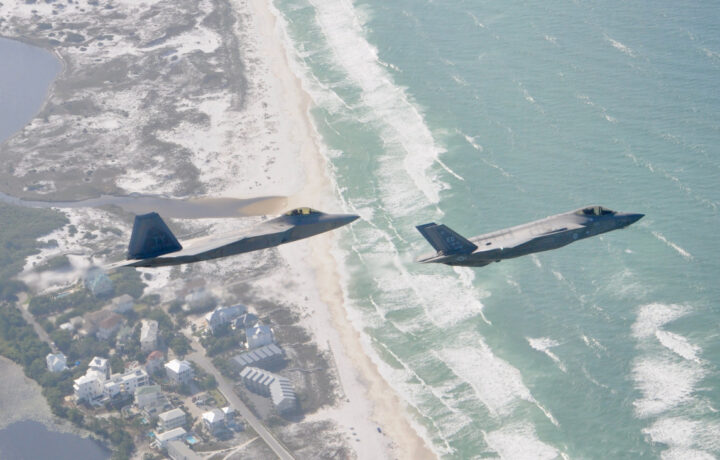Located 12 miles east of Panama City, FL, and named in honor of World War I pilot 1st Lt. Frank Benjamin Tyndall, Tyndall Air Force Base is now home to 2,902 active duty service members, while the base operating unit and host wing are the 325th Fighter Wing (325 FW) of the Air Combat Command (ACC). It was first created on December 7, 1941, as a gunnery range, and following the establishment of the United States Air Force in 1947, it was renamed Tyndall Air Force Base (AFB).
Earlier this month, the facility welcomed Air Force Chief of Staff Gen. CQ Brown, Jr. to what has been described as the Department of Defense’s (DoD’s) initial “Installation of the Future” (IoF). While visiting the base, Brown was able to see first-hand the evolution of the $4.9 billion rebuild, while he reportedly discussed the progression of three incoming F-35A Lightning II squadrons as the 325th Fighter Wing transitions into a combat-coded mission.
It was in late 2018 that the U.S. Air Force made the decision to transform Tyndall AFB, which occurred as the facility was still recovering from Hurricane Michael’s devastation. In the process, Tyndall was also to be transformed into the testing grounds for some of the newest technology the world had to offer.
Since that time that base has been on a continuous innovation journey, the Air Force reported last July. The service had noted at the time that the Air Force Civil Engineer Center’s Natural Disaster Recovery Division had been at the forefront of implementing new technologies to reshape the installation into a model of adaptability, efficiency, and sustainability for the Department of the Air Force and Department of Defense.
Established in 2021 by the Air Force Installation and Mission Support Center, AFCEC’s NDR leads the Tyndall AFB Program Management Office.
Projecting Combat Airpower
During Brown’s visit to the base this month, he made sure his message remained clear – namely that the U.S. Air Force must continue to be ready to project combat airpower on behalf of America.
“We want to be so good at what we do that our adversaries wake up every day and go, ‘not today,'” Brown said, who initiated the “Accelerate Change or Lose” directive in August 2020. It was further highlighted while hosting an all-call for the Airmen of the 325th FW during his visit. As the home of air dominance, Tyndall AFB plays a tremendous role in supporting that vision.
“Personally and professionally, I do not play for second place. I play to win,” Brown said. “We want to do everything we can to posture the Air Force to ensure we can win.”
Out With the Not So Old
As part of the evolution at Tyndall, its F-22 Raptor training mission is now evolving into an F-35 combat-ready mission and represents a massive change for the Air Force to ensure readiness. Tyndall’s first F-35 is expected to arrive in August of this year.
“Bringing in the F-35 squadrons increases the combat capability of our Air Force,” Brown added. “That is an important aspect for us to be able to execute our mission to ensure we can compete, deter and win if called upon to do so.”
In support of the new mission hosting the F-35, Tyndall can likely expect an influx of airmen and their families. In preparation for their arrival, Sharene Brown, spouse of the Air Force chief of staff, shared her Five and Thrive initiative during the visit.
“While building the installation of the future, Team Tyndall is prioritizing what is needed for Airmen and their families – resources to support education, housing, spouse employment, health care and childcare,” Sharene explained.
Brown’s visit provided further airmen across the installation an opportunity to understand how top Air Force leaders make decisions and what their role is in the fight. The Air Force reported that ‘Checkertails’ remain mission ready and will be prepared to execute when their nation calls upon them.
“I want to be ahead of the pacing challenge,” Brown said. “I want to continue to push to ensure we provide our Airmen the capabilities so we continue to be the most respected Air Force in the world.”
The Model For Bases of the Future
As a test bed, a number of notable new platforms and technologies are being tested at Tyndall, including an artificial weapon-detecting intelligence system as well as the “Digital Twin,” a system that allows military personnel and contractors to design multi-layered infrastructures and resolve potential building issues, all before the ground is broken. These new systems and more will all be controlled by the Installation Resilience Operation Command and Control.
Tyndall is also just the jumping-off platform for these systems, as the service has noted that many other bases can take the work done here and apply it to their respective specific mission sets.
In 2017, the U.S. Army also launched its own initiative for IoF, which will incorporate “smart technology” to create installations that support readiness, are resilient to disruptions, and are sustainable. Four years ago, the Army also sought feedback from industry on ways to leverage emerging technology to transform the way it operates and maintains its bases. That came despite a nearly flat budget, but it now appears that the DoD’s IoF is very much on track.



